Arranging furniture in a living room can seem like a daunting task. With so many pieces to consider, it’s easy to feel overwhelmed. However, a well-designed living room looks great and enhances your lifestyle. The right furniture layout promotes better traffic flow, defines spaces for different activities, and highlights your room’s best features. Follow this comprehensive guide to arrange furniture in your living room like a pro.

Understanding Your Living Room Space
Before choosing furniture or deciding on a layout, you need to assess the dimensions of your living room fully. Understanding the exact size and shape of the space will make it easier to develop the floor plan.
Measuring Your Living Room Accurately
Take time to measure your living room carefully. Note the length and width. Don’t forget to measure any awkward angles, alcoves, or offsets. Bay windows and fireplace nooks impact furniture placement, so their measurements are crucial.
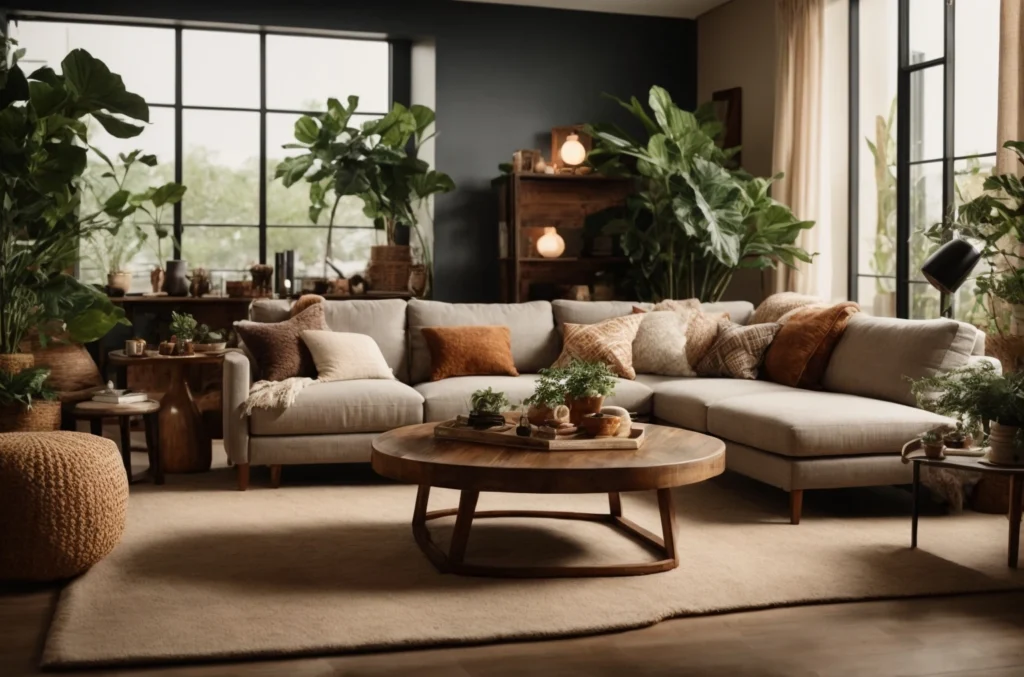
You’ll need a measuring tape for precision. For living rooms with a complex shape, sketch the layout on graph paper first. This helps you calculate the area accurately when there are multiple offsets and angles.
Why Living Room Dimensions Matter
Your measurements form the basis for arranging furniture. The size and proportions of the room dictate what type and how many pieces you can accommodate.
Knowing the exact square footage helps you choose the appropriately sized rug. Oversized rugs make the room look smaller. On the other hand, a too-small rug leaves awkward gaps between furniture.
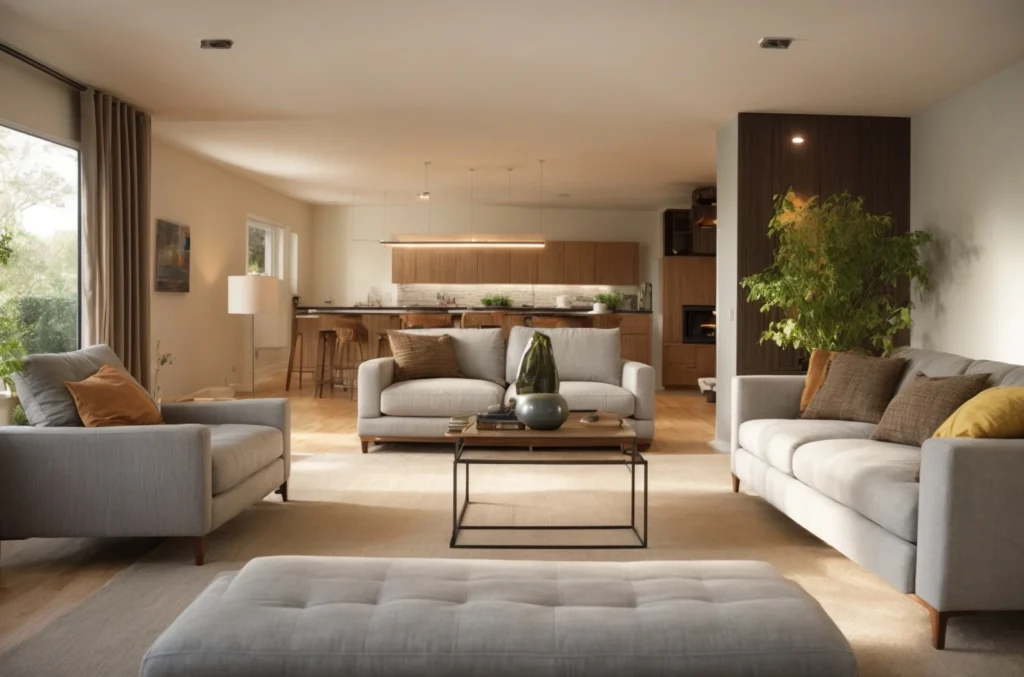
Accurate dimensions allow you to create a furniture layout diagram or use an online living room planner. This takes the guesswork out of deciding where to place each piece.
The Concept of Traffic Flow
One of the keys to functional living room furniture placement is understanding traffic flow. Traffic flow refers to the natural pathways people walk through a space. Identifying and accommodating traffic flow is essential for an efficient, workable living room layout.
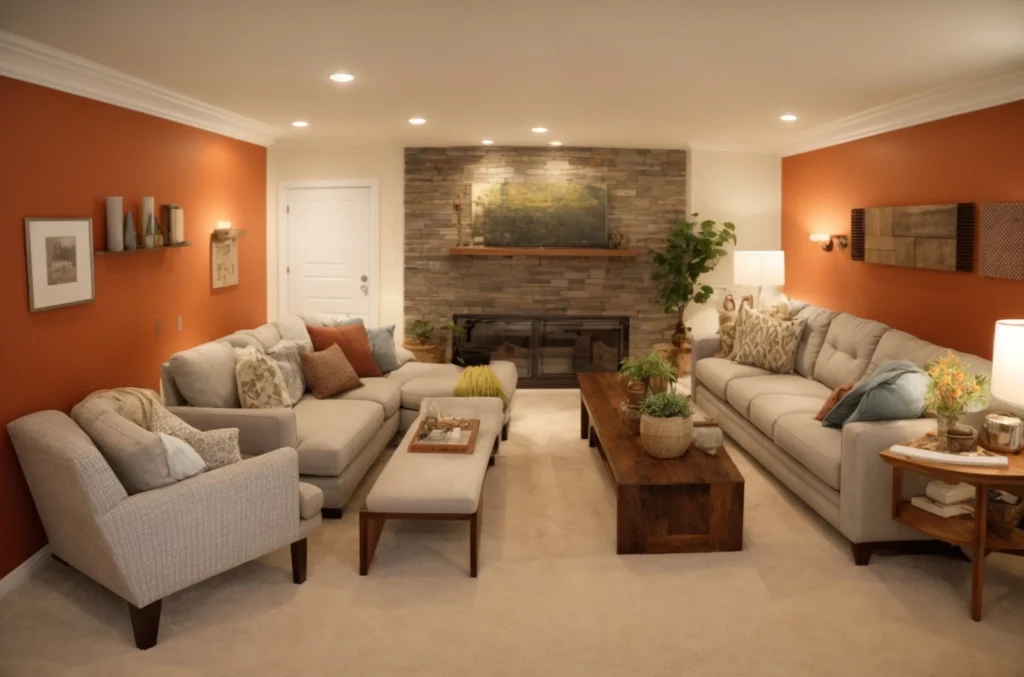
How to Identify the Room’s Natural Traffic Flow
Consider the living room’s entryways and openings. The most-used pathways between entrances, exits, and openings dictate the traffic flow.
For instance, if the main entry is in one corner but the opening to the dining room is centrally located on a different wall, the natural traffic flow is diagonally from corner to center.
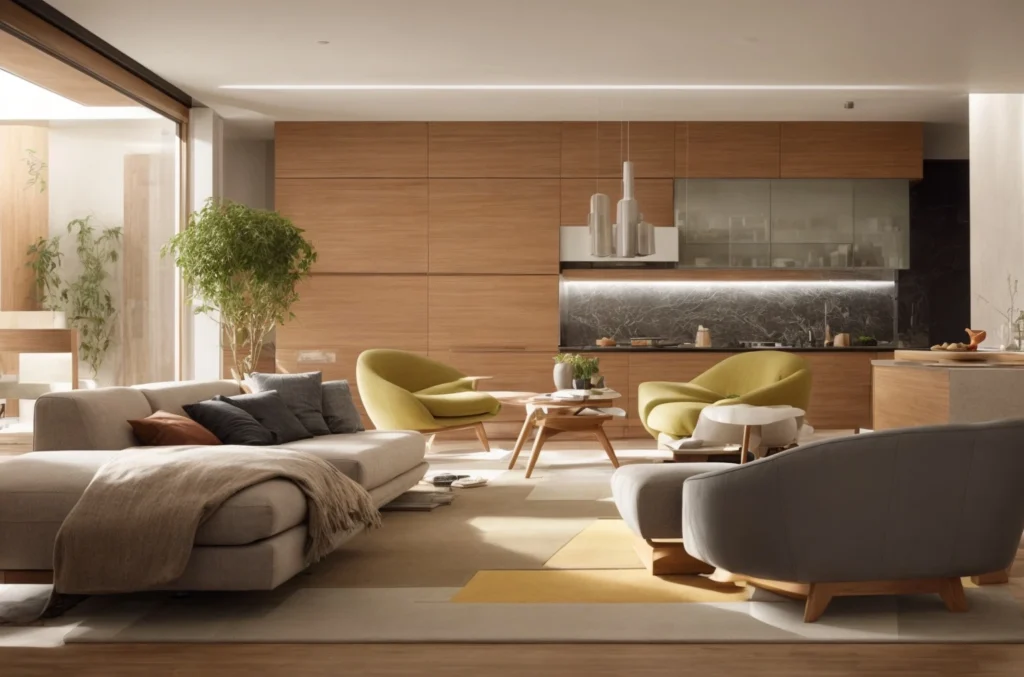
Make sure openings don’t get blocked. Allow for open circulation routes through doorways. Leave enough space for traffic to flow around and between furniture groupings.
Why Traffic Flow Matters in Living Room Layouts
The room won’t be comfortable or functional if the furniture layout ignores or restricts the natural traffic flow. Bottlenecks and dead ends frustrate movement and disrupt harmony.

Unobstructed traffic pathways allow people to move freely through the space. Straight circulation routes give a smooth, sensual flow. Curved routes encourage more creative energy according to feng shui principles.
Design Tips for Optimizing Traffic Flow
- Leave enough space between furniture pieces and walls. Narrow circulation routes make a room feel cramped.
- Arrange furniture in symmetrical groupings or zones. This provides organized walkways.
- Use area rugs to define spaces while keeping the flow open between groupings.
- Float furniture away from walls and boundaries. This maintains flow on all sides.
- Avoid clutter that blocks or disrupts movement through the room.
Focal Points in Living Room Design
Every living room has at least one focal point—the visual center that attracts the most attention. Focal points provide an anchor for furniture arrangement and impact positioning.
Living Rooms with Fireplaces
A fireplace naturally becomes the focal point if your living room has a fireplace. All furniture should face the fireplace to create a central gathering area.

Place the primary sofa directly opposite the fireplace. Angle the other seats toward the hearth. Float chairs at the sides to widen the conversation area.
Don’t obstruct the view by placing a TV above a working fireplace. This competes with the fireplace as the focal point.
Arranging Furniture Around Other Focal Points
In living rooms without fireplaces, focal points may include:
- Large windows with a beautiful view
- Media centers or wall-mounted TVs
- Display units like bookcases or curio cabinets
- Entryways with distinctive architectural features

Arrange seating to face the focal feature. Complement it with end tables, floor lamps, plants, or artwork. This highlights the visual magnet pulling the room together.
Living Rooms With Multiple Focal Points
If your living room has two strong focal points, zone furniture in separate arrangements around each one.
For instance, create one seating cluster around the fireplace and another around a bay window. Link the two zones with a rug extending between both areas.
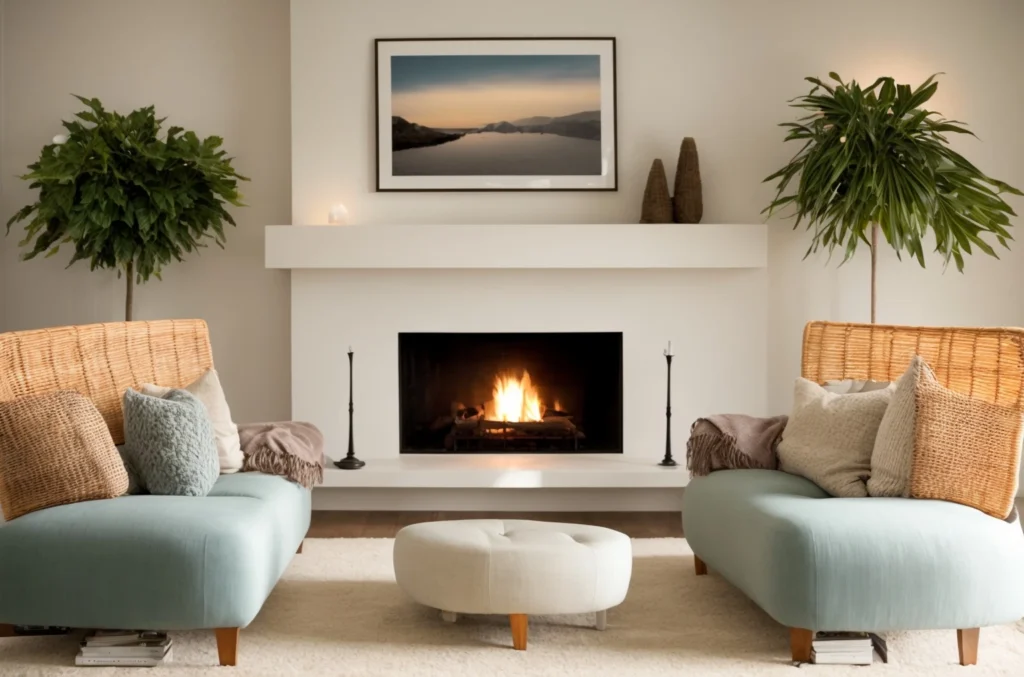
Or designate the fireplace as the winter focal point and large windows as the summer one. Rearrange furniture seasonally to utilize both.
Living Room Layouts
Once you understand the architecture, measurements, traffic flow, and focal points, it’s time to map out potential living room layouts.
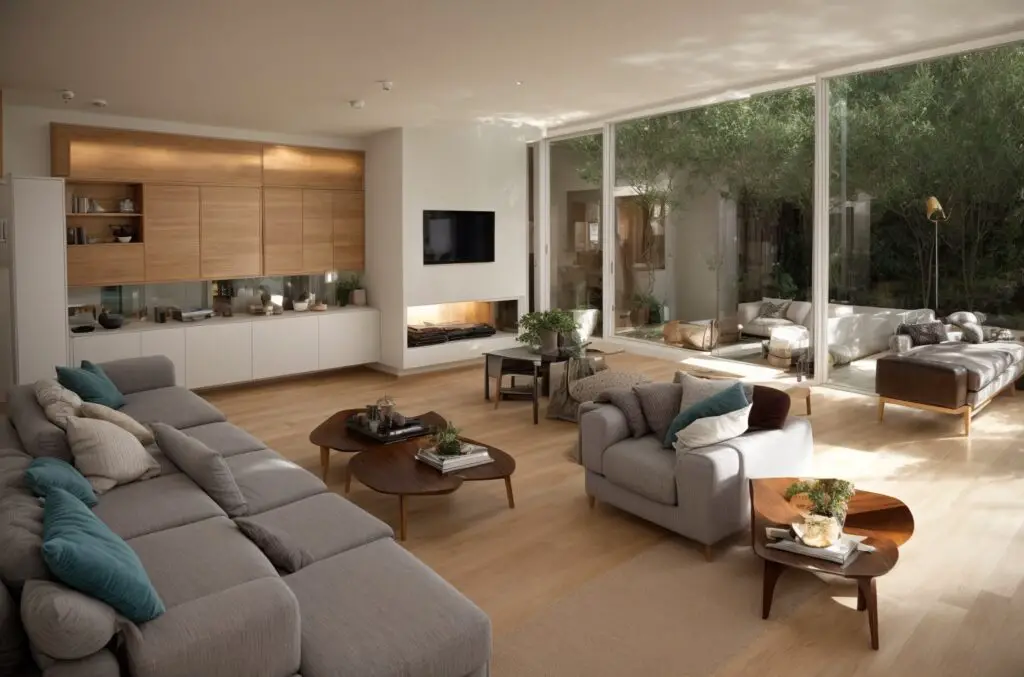
Types of Living Room Floor Plans
Common living room layouts include:
Formal: Furniture placed symmetrically against the walls and typically used in large, square rooms. It allows unobstructed flow but feels stiff.
Informal: Asymmetrical arrangement with furniture angles. Creates separated activity areas. Feels more relaxed but can disrupt the flow.
Conversational: Furniture grouped around a focal point to promote interaction. It allows easy flow between arrangements but uses space inefficiently.

Consider your room’s size, shape, entrances, and focal points when choosing a layout. The informal conversational plan offers flexibility for most living rooms.
Creating a Floor Plan Diagram
A floor plan diagram is a bird’s eye view showing where each piece of furniture will go. It helps you experiment with arrangements before moving heavy pieces.
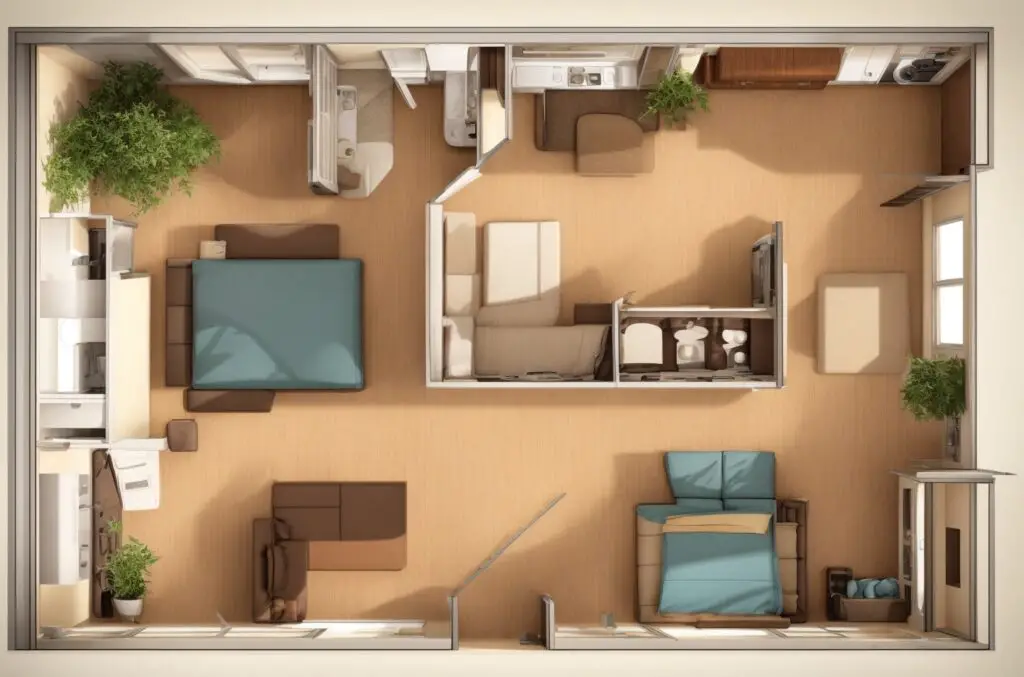
To make a floor plan:
- Sketch the room’s shape with exact wall dimensions
- Add openings, windows, pillars, and focal points
- Indicate traffic pathways with dotted lines
- Play with standard furniture templates to find the optimal placement
Online interactive floor planners can also generate layouts based on your room measurements.

A floor plan helps finalize the living room layout before arranging furniture.
Arranging Large Living Room Furniture
The biggest living room furniture—sofas, sectionals, media consoles, dressers, etc.—make the most impact. Their positioning sets the tone for the whole layout.

Where to Place Large Furniture Pieces
Follow these general guidelines when arranging large items:
- Place the main sofa opposite or at a slight angle to the focal point. This creates a central gathering area for seating.
- Loveseats and chairs should flank larger sofas to balance the arrangement.
- Sectionals can define zones in open-plan living rooms. Float them parallel to traffic flow.
- Angle media consoles toward seating areas to avoid obstructing flow.
- Dressers and sideboards work well as room dividers or anchors for fluid layouts.
Dealing With Too Much Furniture
Some pieces will have to go if your existing furniture is excessive for the room’s dimensions. This allows you to arrange the remaining furniture comfortably.
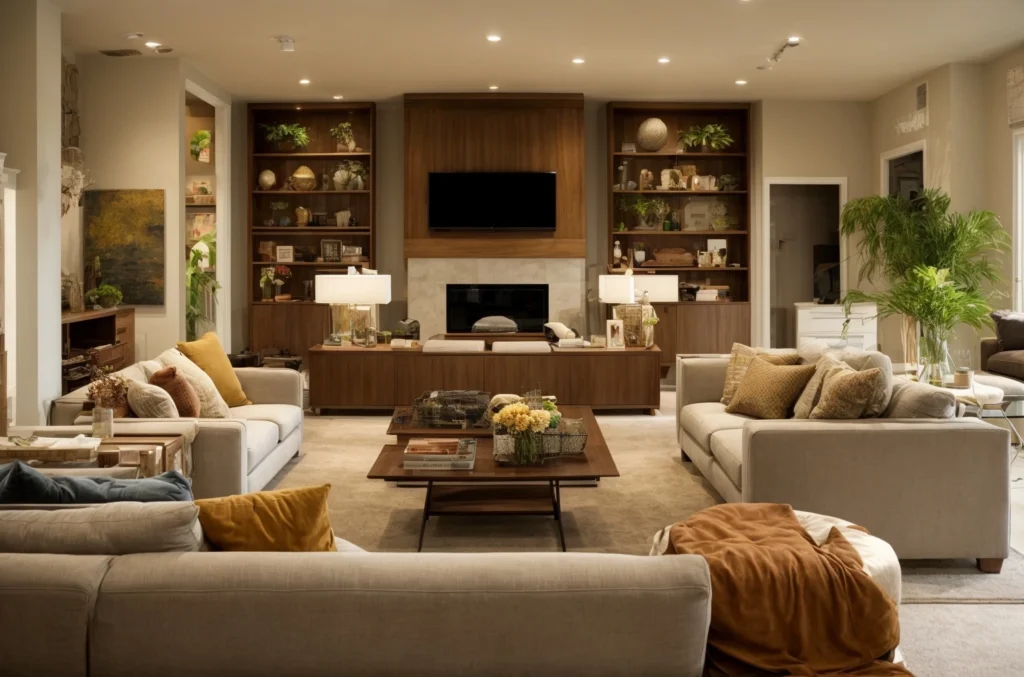
Consider removing rarely used cabinets and display units first. Then identify duplicates that serve the same purpose, like two coffee tables or matching end tables. Limit furniture to only essential, useful pieces.
Arranging a TV and Fireplace
Living rooms with both a TV and fireplace offer double the focal points. The layout needs to accommodate viewing needs while preventing awkward neck craning.
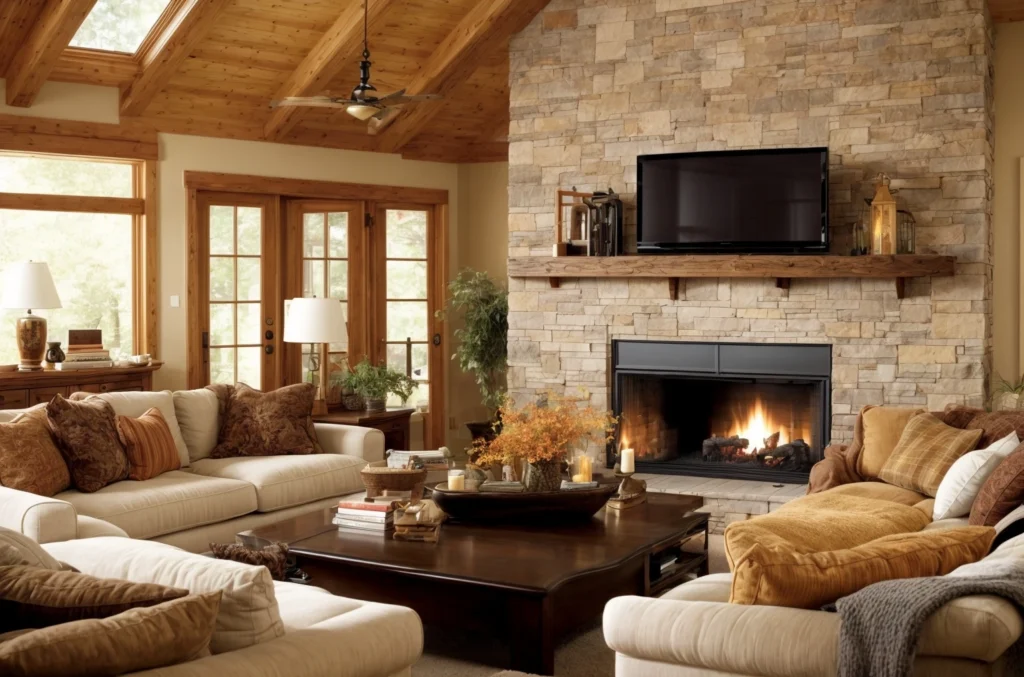
TV Placement Guidelines
Follow these tips for placing a TV in a living room with a fireplace:
- Mount the TV on the wall adjacent to the fireplace. Angle it for comfortable viewing from seating areas.
- If the fireplace has a wide mantel, place the TV above it. Raise it at least 18 inches above the mantel to prevent neck strain.
- In a corner fireplace, use the adjacent wall for the TV. Float furniture towards the diagonal center of the room.
- Place the TV on a media console along another wall. Position seating in between the TV and fireplace zones.
Alternating Priority
During colder months, make the fireplace the primary focal point and minimize TV use. In warmer seasons, make the TV the main focus for media viewing.

Rearranging the furniture periodically accommodates alternating seasonal priorities between both elements.
Creating Conversational Areas in Living Rooms
While traffic flow and focal points provide structure, don’t forget to create inviting spaces for conversation. Cluster furniture into intimate groupings suitable for relaxing and chatting.

Conversation-Friendly Furniture Placement
- Float seating around side tables or ottomans to allow easy interaction.
- Angle chairs toward each other rather than flat against walls.
- Place sofas and loveseats perpendicular rather than parallel. This encourages people to face each other.
- Separate opposing chairs and sofas by 20
- Separate opposing chairs and sofas by 20 to 30 inches. This allows room for end tables without feeling cramped.
- Use lighting to define conversation areas. Overhead lights feel too harsh. Opt for table and floor lamps.
- Add stylish poufs or stools to provide extra casual seating for guests.
Creating Defined yet Flexible Zones
Use area rugs, distinct lighting schemes, or changes in flooring to delineate conversation areas while keeping them connected.
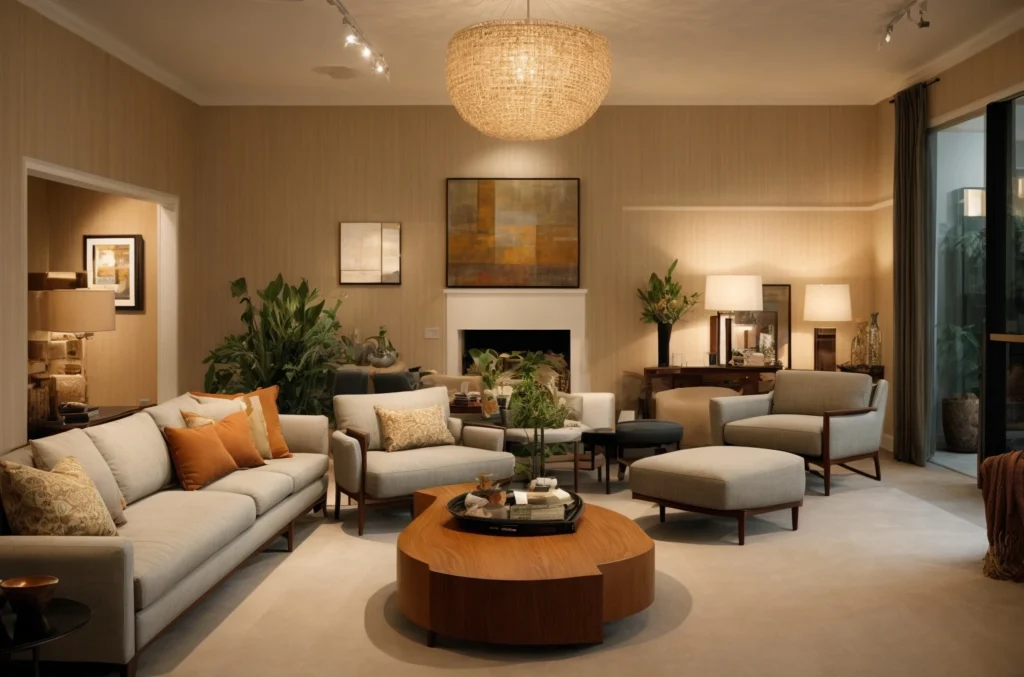
For example, add a patterned rug under the seating cluster around a fireplace, but use solid rugs under the remaining furniture. This defines zones without compartmentalizing the layout.
Furniture Arrangement Tips for Small Living Rooms
Small living rooms can still be stylish and welcoming if you choose the right furniture and adopt space-saving layouts. Follow these tips to make a little room feel luxe.
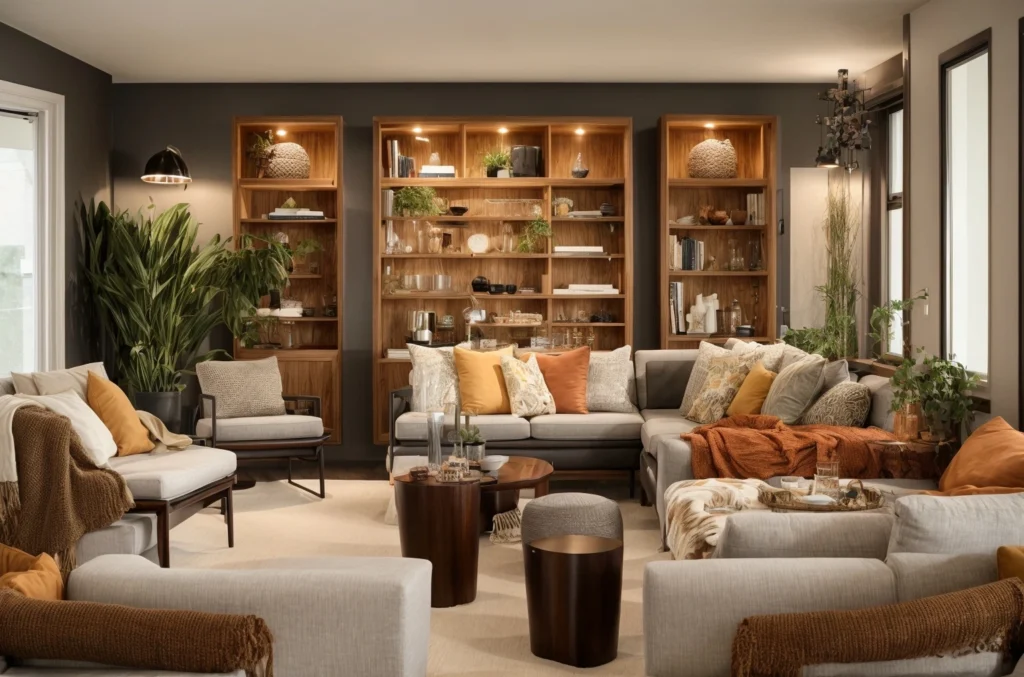
Working With Narrow Living Rooms

Avoid lining furniture along the walls if your living room is long and narrow. This exaggerates the bowling alley effect. Instead:
- Float furniture out from the walls to allow flow behind pieces
- Angle furniture arrangements to avoid a rigid, linear look
- Use a tall but narrow media unit instead of a low wide one
- Separate seating groups at opposite ends with a narrow console table
Making the Most of Limited Space
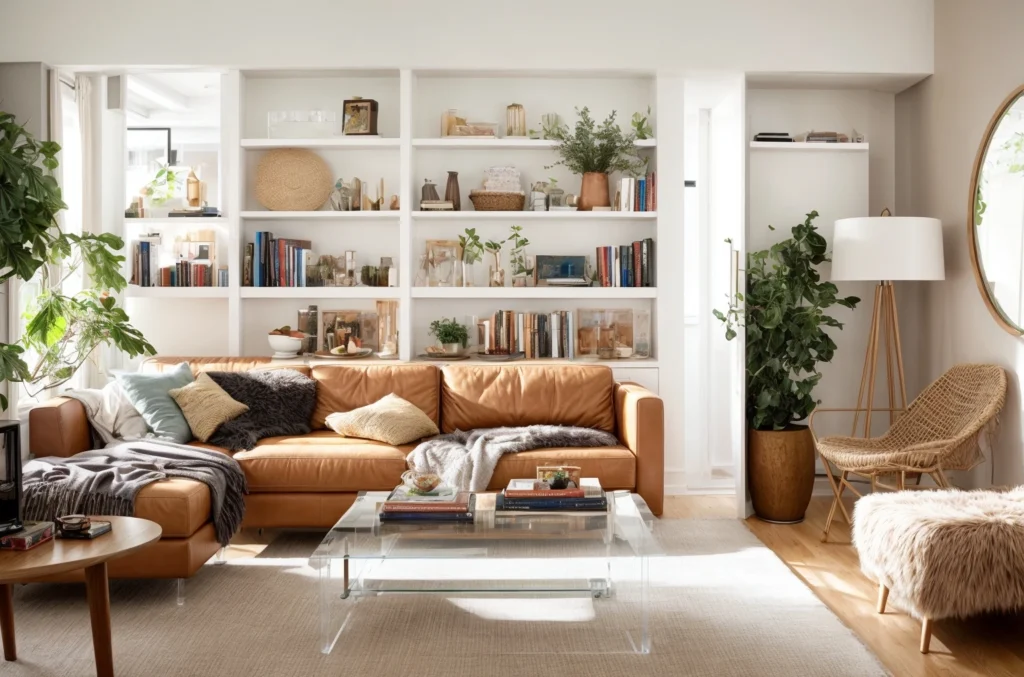
Maximize every inch in a tiny living room using these clever ideas:
- Look for furniture with exposed legs or transparent acrylic bases. Visible floor space makes rooms seem larger.
- Coffee tables with lift tops provide discreet storage without clutter.
- Nestle ottomans under console tables to serve as alternate seating.
- Replace bulky media cabinets with wall-mounted shelves and TVs.
Special Considerations for Unusual Layouts
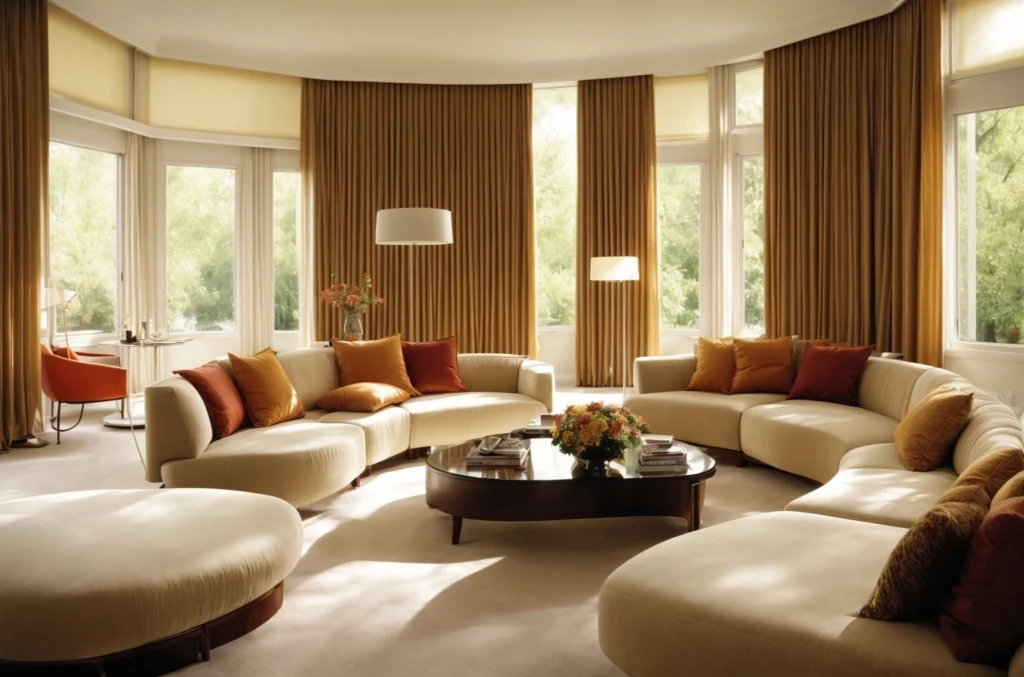
Make the most of challenging living room architecture with unique layouts:
- Long, narrow rooms use a sectional to divide the space into two zones.
- Float furniture diagonally in trapezoid-shaped rooms.
- Position chairs at either side of protruding bay windows to create a curved conversation area.
Apps and Tools for Furniture Arrangement
Technology offers handy solutions for visualizing room layouts digitally before physical arrangement. Here are some options:

Interactive Floor Planners
Websites like planner5d.com and roomstyler.com allow you to create customized 2D and 3D living room layouts. Just enter room dimensions and add illustrations of your actual furniture pieces. Experiment with arrangements digitally in a simulated view of your space before moving heavy pieces.
Augmented Reality Apps
Mobile apps like Livspace, Place, and RoomScan use augmented reality to overlay your existing living room with recommended layouts digitally. Just scan the room, upload furniture choices, and preview Arrangements on your smartphone screen imposed over the real physical space. This takes the guesswork out of placement.
Shopping with Room Planners
Retailers like IKEA and Crate and Barrel have interactive room planners on their websites. You can browse their furniture collections and create proposed arrangements digitally using their products customized for your space.
Final Touches for a Well-Arranged Living Room
Once the major furniture pieces are in place, it’s time for refinements to make the layout complete. Add final decorative touches to create an inviting ambiance.

Incorporating Functional and Decorative Tables
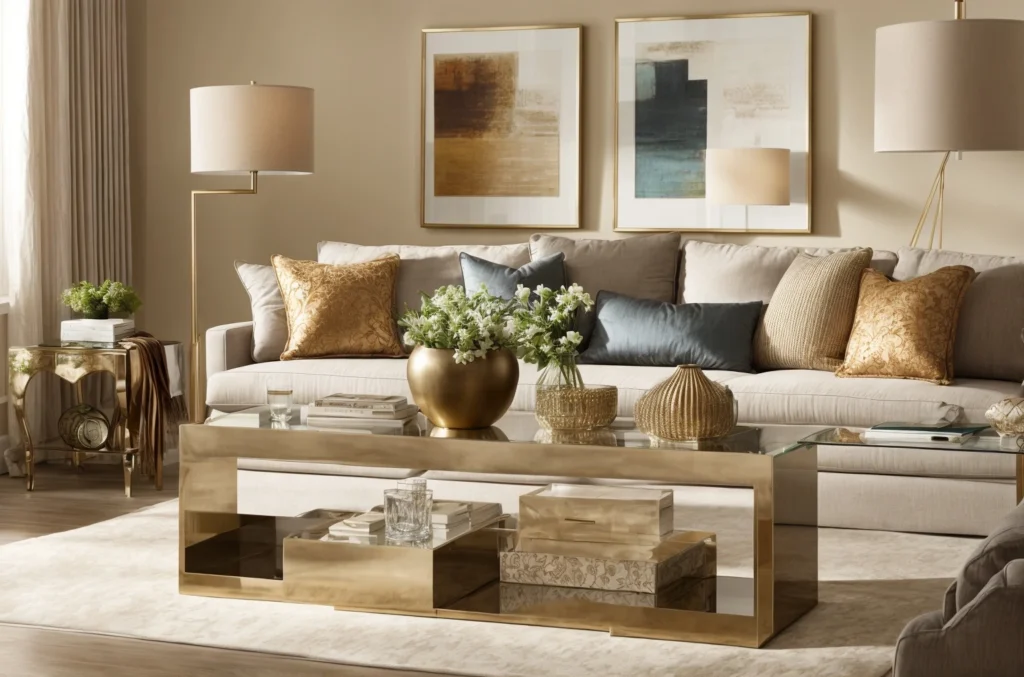
Introduce side tables like these for aesthetics and usefulness:
- Nestle end tables beside sofas to hold lamps and reading material.
- Place console tables behind seating areas for displaying collectibles.
- Use coffee tables to anchor seating clusters while providing a surface for food and drink.
- Add a petite accent table in empty corners to balance layouts.
Area Rugs

Rugs tie the layout together visually. They also make the room more comfortable:
- Please choose a size that fits at least the front legs of all seating furniture placed on it.
- In open-plan living rooms, use multiple rugs to define separate zones.
- Ensure furniture legs sit at least 6 inches from the edge so furnishings don’t look crammed.
Accessories

Embellish your living room further with:
- Artwork, plants, and sculptures arranged in groupings rather than scattered randomly.
- Attractive baskets or ottomans for storage instead of unsightly clutter.
- Books and collectibles placed on shelving or coffee tables.
- Pillows, throws, and fresh flowers to enhance comfort and vibrancy.
Conclusion
Arranging living room furniture may seem complicated initially. However, focusing on traffic flow, focal points, room dimensions, and conversation zones simplifies the process. Start by mapping out your existing space and thinking about usage patterns.
Then use a floor plan to experiment with different configurations digitally before setting up the room. This helps avoid mistakes that require repetitive furniture moving. Following the tips in this guide, you can create a living room layout tailored to your space, needs, and lifestyle.
The right arrangement not only looks great but enhances your living experience. So take time to get it right using the principles and guidelines covered here. You can craft a living room beyond function with a systematic yet creative approach to deliver form, flow, and flair.
